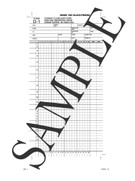
Conway Cleveland 36" Log Rule | Doyle, International or Scribner Scale
- Brand
- Conway Cleveland
- SKU:
- 15xLOGRULE
- Condition:
- New
- Availability:
- Available for order
Conway Cleveland Log Rule | Doyle, International or Scribner Scale
Used to determine board feet or lumber content of logs.
Conway Cleveland's Log rules are manufactured from fine hickory and walnut and feature a stainless steel oval head. The black numbers are clear and bold are protected by a polyurethane coat.
Choosing a scale for the log rule:
1. Doyle Log Rule
The Doyle rule is the most common rule used in hardwood log scaling. Edward Doyle developed this log rule prior to 1850. The log rule with the Doyle Scale estimates the volume based on log length, diameter, slabs, edgings, shrinkage and production of sawdust. The allowance for slabs and edgings is too large for small logs and is too small for large logs. Also, the rule allows for only a 4.5 percent reduction of log volume for sawdust and shrinkage where most rules allow between 10-30 percent. There is no allowance for taper.
2. Scribner Log Rule
J. M. Scribner developed the Scribner log rule in 1846. This rule is based on a series of diagrams outlining the sawing pattern for 1-inch lumber for each diameter and length class with a 1/4-inch allowance for saw kerf. Taper is not accounted for in the rule, so it under-estimates volumes for logs more than 16 feet in length. One disadvantage of this rule is that there is no uniform slab allowance for log diameters. A change was made to the basic Scribner rule in the early 1900s to make it easier to apply. This new rule is known as the Scribner Decimal C rule and is different from the standard Scribner rule in that all volumes are rounded to the nearest 10 board feet. For example, a log that scales 64 board feet would be rounded to 60 board feet. This rule is commonly used on the West Coast and in the South for pine saw logs.
3. International 1/4 - inch Log Rule
Judson C. Clark originally developed this formula-based rule around 1906 as the International 1/8-inch rule. In 1917 he developed the International 1/4 inch rule, which increased the saw kerf allowance to 1/4-inch in the formula. This 1/4-inch rule is the form used today. The rule is based on analysis of losses that occur during the conversion of sawlogs to lumber and is one of the few rules that incorporates taper. The rule assumes a taper of 1/2 inch in 4 feet. All calculated values are rounded to the nearest 5 board feet. This rule is generally used in timber sales in eastern national forests. This is the most accurate rule of the three discussed.















